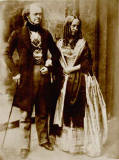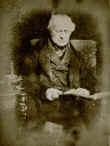|
Early Photographic Processes Calotype 1841-1850s |
||
|
Discovery |
The 1830s - early experiments Having had some success with his photogenic drawing, sometimes placing an image directly on his paper and sometimes photographing it with one of his small wooden cameras in the mid-1830s, Talbot turned his attention to his other interests. It was not until Daguerre's photographic process was announced in 1839 that Talbot seriously turned his efforts again to finding an improved process. |
|
|
The 1840s - the Calotype process Talbot discovered his Calotype process in September 1840. He announced his discovery on 8 February 1841, though at that stage he gave no details of the process. He patented the process later in 1841. The attraction of the calotype process was that it enabled a latent image on the paper to be transformed into an actual image after the paper had been removed from the camera. The calotype process allowed much shorter exposures than for photogenic drawing, and so made portraits possible. Exposures of around 1 to 3 minutes might be required for a calotype. Talbot's earlier photogenic drawing process might have required an exposure of an hour. So calotype portraits became possible, as demonstrated by Talbot in October 1840 and by Hill & Adamson in Edinburgh from 1843 to 1847. |
||
|
The 1850s Throughout the 1840s, the two photographic processes used were daguerreotype and calotype. But, by the 1850s, most photographers were using the newly-introduced and patent-free wet collodion process. However, John Dillwyn Llewelyn, married to a cousin of Talbot, continued to use the calotype process for landscape photography, believing it to produce results that were more sympathetic to the subject. [Richard Morris] |
||
|
Process |
NOTE ON EARLY PROCESSES The calotype process, and other early photographic processes involve the use of acids. and other chemicals. These require a good understanding and extreme care . I am not in a position to give advice or guidance. This site merely gives an overview of the process, without full details, so that we can get a general understanding of the process, and appreciate the amount of work that must have been involved for the early photographers. Please note that this web site should NOT be used as a source for anybody wishing to experiment with or use old photographic processes. |
|
|
Below are the steps that were taken to create a calotype negative: |
||
|
Iodise the Paper 1. Find a suitable paper. Many of today's papers contain hypo or other chemicals that make them unsuitable for the calotype process. A white paper, with a good wet strength, not made from wood pulp, and free from watermarks is required. [Talbot favoured a rag/gelatin paper from Whatman] 2. Brush onto the paper an 8% solution of silver nitrate in distilled water. Allow the paper to become matt dry.
3. Immerse the paper in a solution
of potassium iodide 2 to 3 minutes.
[Should this be done under a red
light?]
4. Dry the paper, then hang it for up to two hours in sunlight. This will help the paper to produce a more contrasty image. At this stage, the paper has a coating of silver iodide, which is insoluble and insensitive to light. This paper should be stored in an acid-free box until ready to use in the camera.
|
||
|
Sensitise the Paper When ready to take the photo, the paper needs to be sensitised as follows, under a red light, using a Buckle Brush (named after Samuel Buckle) or cotton wool held in a glass tube, in order to get a good even coating on the paper. 5. Under a red light, coat the iodised paper with an silver nitrate in distilled water. Other chemicals are also required at this stage. I believe that these include glacial acetic acid and gallic acid Blot the paper to remove excess liquid, then cut to size for the camera. |
||
|
Expose the Paper 6. While the sensitised paper is still wet, expose it in the camera. A two minute exposure at f8 may be required on a sunny day. |
||
|
Developing 7. Brush a solution of silver nitrate (similar to the sensitising solution but stronger) over the paper, followed by gallic acid. [Possibly also use acetic acid.] The image should appear, perhaps in half an hour, or 3 to 4 hours on a cold day. The image is ready when it shows a good contrast, viewed in red light. |
||
|
Fixing 8. Wash the paper, then fix in potassium bromide or hypo to create the calotype negative. Initially, iodides were used for fixing. Talbot initially fixed his image using a solution of potassium bromide.
Herschell recommended the use of hypo (sodium
hyposulphite - now known as sodium thiosulphate) as a fixing agent but
Talbot was not keen to use this because it tended to bleach his
negatives. The action of hypo was known before the calotype process was discovered. But hypo was expensive and difficult to use successfully, so it was not universally used in the 1840s. In fact, in the early days, it may have destroyed more photos than it helped. Wash the paper, then dry. |
||
|
The Calotype Paper Negative 9. The result of the process above is a negative image. This is the calotype.
For
Talbot, the negative image was an end in itself. For Hill & Adamson and others, it was the final print that was important. They frequently touched up their negatives by hand, strengthening lines and adding sky detail. Several of the early photographers had no difficulty in making the calotype negative, but had trouble converting it into a good salt print. |
||
|
The Paper Print 10. The calotype created above can then be used to make any number of prints, using the Salted Paper print process. Alternatively, an Albumen print, or a Cyanotype print could be made from the calotype negative. |
||
|
Waxing the Print 11. In the 1850s, it became common practice to wax the calotype negative on the back, using beeswax, to make it translucent, before making the salted paper print. This preserved more detail in the print, and prevented the fibres of the paper from being seen in the print. If calotype prints are being made today, a sheet of acetate is recommended between the negative and the paper for the print, to avoid contamination of the print. |
||
|
Chemicals for the Calotype Process Below is a list of chemicals for the Calotype process, taken from the catalogue of Bland & Long published in 1856. Please click on the list below for further details.
|
||
|
Result |
The calotype negative, like any other negative, had the light and dark tones reversed. It was not normally considered as an end in itself (except by Talbot). The calotype negative was brown when first produced, but began to turn a purplish tone after about 4 hours. Hill & Adamson and others used the calotype negative to make salted paper prints. These were small brown images, often unsharp, and now often faded around the edge.
The image could be very subtle and had its own charm - especially when practiced by Hill & Adamson. |
|
|
The calotype negative was often waxed until it was translucent, in order to prevent the fibres from the calotype negative being seen in the final print. It was possible to make changes to the calotype negative using a pencil, or to cut up negatives to make a colage, before producing the final print. |
||
|
In Edinburgh |
Talbot After publishing The Pencil of Nature, the first book in the world to be illustrated with photographs, Talbot came to Scotland with his camera. He took several photographs of Edinburgh, including the Scott Monument, and Heriot's Hospital. These were used as illustrations in his book, The Sun Pictures of Scotland. The Calotype process was patented in England and Wales, but not in Scotland. |
|
|
Hill & Adamson Hill & Adamson, in Edinburgh, achieved some remarkable results, producing several thousand calotype images between 1843 and 1847. Adamson died at the age of 26 in early 1848.
Many exhibitions of calotypes of Hill & Adamson are planned for 2002, the bi-centenary of the birth of DO Hill. |
||
|
Edinburgh Professional Photographers Early photographers who set up calotype businesses in Princes Street, Edinburgh, in the 1840s included: - Thomas Davidson, who also manufactured lenses - James Ross, who formed several partnerships - James Good Tunny, who taught photography to many of Edinburgh's early photographers. |
||
|
Acknowledgements: 1. The book, The Origins of Photography, by Helmut Gernsheim 2. Richard Morris, who gave a demonstration of the calotype process in Edinburgh on 11 May 02, as part of the DO Hill Bi-Centenary celebrations, and who subsequently provided detailed notes for others wishing to make their own calotype negatives. Extracts from these notes have been used in describing the calotype process above. |
||


